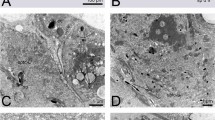Abstract
Apolocystis elongata lies in the seminal vesicles of the worm Eisenia foetida (Sav.). As we have seen by light microscopy, Apolocystis possesses a cuticle thickly covered by a pile of short hair-like processes each about 4µ long and 0.5µ thick. The processes do not show obvious signs of movement. The animal is a passive feeder. In our investigation by electron microscopy we have been particularly interested in determining the ultra-structural organization of the body-wall and hair-like processes.
This is a preview of subscription content, access via your institution
Access options
Subscribe to this journal
Receive 51 print issues and online access
$199.00 per year
only $3.90 per issue
Buy this article
- Purchase on Springer Link
- Instant access to full article PDF
Prices may be subject to local taxes which are calculated during checkout
Similar content being viewed by others
References
Palade, G. E., J. Exp. Med., 95, 285 (1952).
Porter, K. R., J. Histochem. and Cytochem., 2, 346 (1954).
Palade, G. E., J. App. Phys., 24, 1419 (1953).
Grassé, P. P., Proc. Stockholm Conf. on Electron Microscopy, 146 (Almquist and Wiksell, Stockholm, 1956).
Author information
Authors and Affiliations
Rights and permissions
About this article
Cite this article
LACY, D., MILES, H. Observations by Electron Microscopy on the Structure of an Acephaline Gregarine (Apolocystis elongata, Phillips and MacKinnon). Nature 183, 1456–1457 (1959). https://doi.org/10.1038/1831456a0
Issue Date:
DOI: https://doi.org/10.1038/1831456a0
This article is cited by
Comments
By submitting a comment you agree to abide by our Terms and Community Guidelines. If you find something abusive or that does not comply with our terms or guidelines please flag it as inappropriate.



